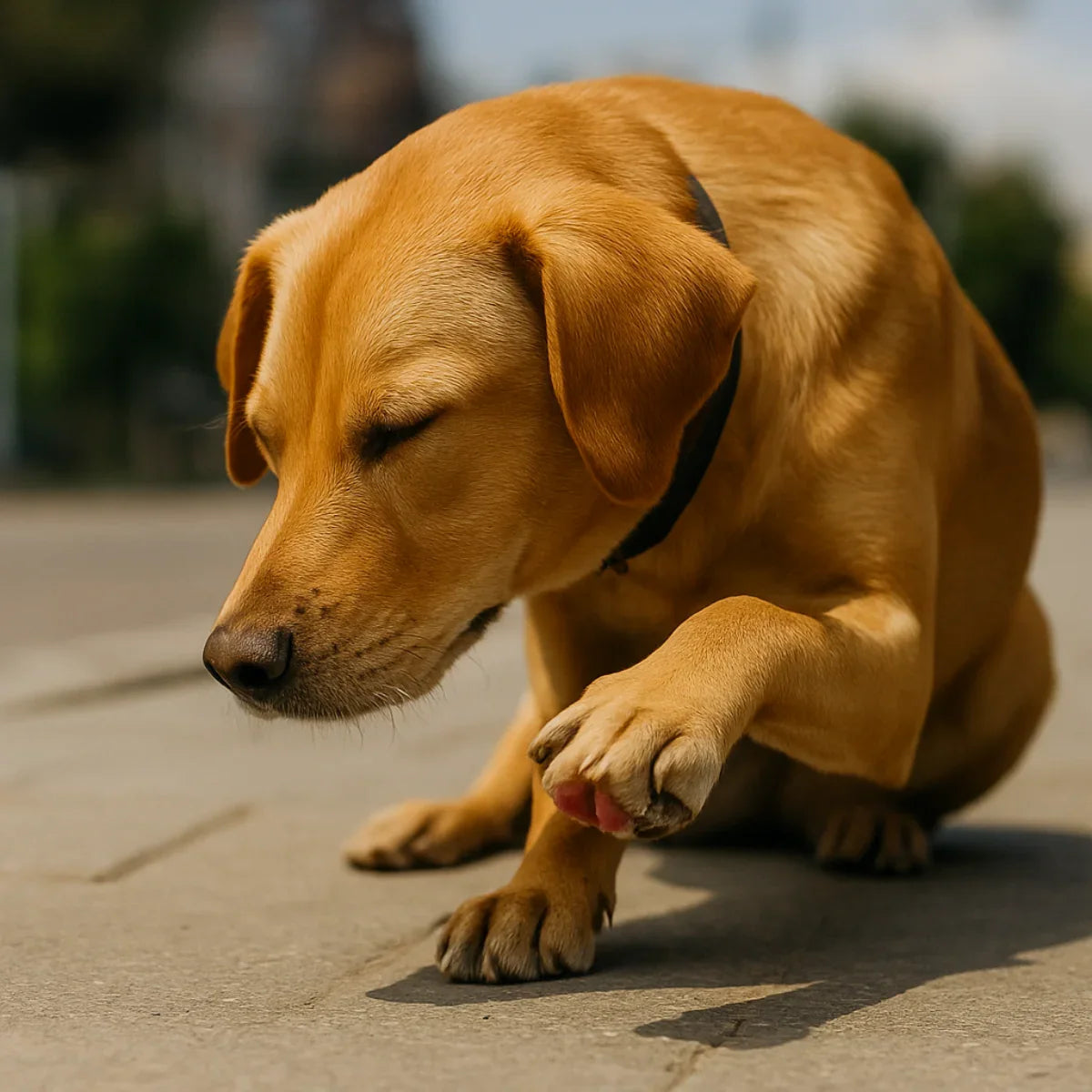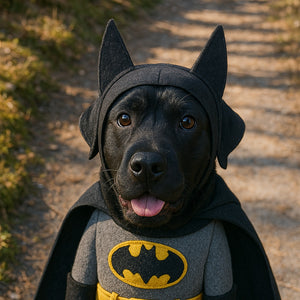
🐶 Does Your Dog Love You? 9 Behaviors That Reveal Your Dog's Affection
Imagine: you come home and your dog is waiting by the door, wagging its tail like a pinwheel, squealing with delight, jumping around you, and then bringing you its favorite toy and sitting right next to you. It's not a coincidence. It's a signal. But can you really say that your dog... loves you?
The question of a dog's love seems trivial – after all, every owner sees how strongly their dog reacts to the presence of a loved one. But what does "love" actually mean in the world of canine emotions? Is a dog capable of deep attachment? Is it just instinct and habit, or is it something much more?
For many of us, a dog isn't just a companion—it's a member of the family. And since that's the case, there's a natural need to understand: does he feel the same way about me as I do about him? Am I special to him, or just a source of walks and a full bowl?
In this article, you'll discover the science behind canine love, what emotional attachment looks like in dogs, and how to recognize that you're more than just a caregiver to your dog. You'll discover 9 clear signs that your dog loves you—more than you think.
🧠 Can dogs love?

It's a question that plagues many owners. After all, we don't hear "I love you" from our dogs, we don't receive Valentine's Day cards, or verbal declarations. And yet, anyone who has formed a true bond with their pet knows that feelings exist. But is it truly love?
From a biological and neuropsychological perspective, dogs don't understand love the way humans do. They lack the ability to think abstractly or evaluate relationships in romantic terms. But that doesn't mean their feelings are any less profound. Quite the opposite.
A dog's brain produces oxytocin —known as the "love and bonding hormone." It's the same chemical that, in humans, is responsible for creating closeness between partners or between mother and child. During physical contact with a caregiver—cuddling, petting, looking into the eyes—oxytocin levels in dogs (and humans!) increase.
Research conducted by Dr. Miho Nagasawa (Azabu University) and Dr. Greg Berns (Emory University), among others, shows that dogs can recognize their owners' emotions, respond to them, and form long-term attachments based on trust. This isn't instinct. It's an emotional bond.
Comparing a dog's emotional development to that of a human, researchers suggest it is equivalent to that of a child around 2–2.5 years of age. This means a dog can feel:
- attachment and trust ,
- jealousy ,
- longing ,
- frustration ,
- and even the need for closeness and security .
A dog's love is revealed not in words, but in the behaviors, body signals, and decisions a dog makes every day . Therefore, it's worth taking a closer look at these gestures – because they hold the answer to the question: "Does he really love me?"
Biologically, dogs don't understand love the way humans do. But their brains produce oxytocin —the same "love hormone" that creates the bond between mother and child.
Research shows that dogs experience emotions similar to those of human children aged 2–2.5 years. They can experience attachment, security, and even frustration and jealousy. Their love isn't expressed through words, but through behavior, presence, and connection .
📊 What Does the Research Say? – The Science of Dog Love
Over the past two decades, scientific interest in dogs' emotions and social abilities has grown. Neuroimaging studies and behavioral experiments are shedding new light on how deep interspecies bonds can be.
- 🧪 Oxytocin and Bonding – Dr. Miho Nagasawa's research has shown that eye contact between a dog and its caregiver increases oxytocin levels in both parents. This is the same mechanism that bonds an infant with its mother.
- 🧠 Brain Activity – Dr. Greg Berns' team (Emory University) conducted MRI studies on dogs. The results show that the areas of their brains responsible for emotions and rewards are activated when they hear their caregiver's voice or perceive their owner's scent.
- 👁️ Interpreting Emotions – Dogs can recognize human emotions based on facial expressions and tone of voice. In a study published in Biology Letters, dogs associated positive and negative facial expressions with the appropriate emotional tone.
- 🐶 Empathy and Attachment – Studies have shown that many dogs react with stress and anxiety when their owner fakes crying, and show a desire to approach and comfort them. This may be a form of empathetic behavior.
All of this leaves no doubt: the emotional bond between humans and dogs has a scientific basis . Dogs don't just love—they do it in their own unique, instinctive, and neurobiologically sound way.
📷 How does a dog show love in different situations?

A dog's love doesn't just manifest itself in one form. Depending on the location, context, and emotional state, dogs express their affection in different ways. Here are some examples of what a dog's affection might look like in everyday moments:
🏠 At home
- Sitting close to you or touching your leg with a paw.
- Bringing toys and placing them on your lap.
- A quiet companion while you relax, cook or read.
🚶 On a walk
- Spontaneous looking in your direction (so-called "checking in").
- Walking up to and touching your hand with your nose while walking.
- Reflexively slowing down to walk beside you.
🛌 During rest
- Choosing a spot close to your bed or couch.
- Putting his head on your legs or chest.
- Calm purring or sighing in your presence – a sign of relaxation and security.
😟 In a stressful situation
- Seeking your presence and support.
- Climbing under the table or on your lap if you feel threatened.
- It will stand "on guard" between you and an alien stimulus (e.g. noise).
👶 In relationship with a child
- Gentle handling of the baby.
- Allowing your child to have physical contact (e.g., hugging).
- Staying close to your child while he or she sleeps or plays.
By observing your dog's behavior in these situations, you can learn to recognize its emotional signals – and respond to its needs even better.
✅ 9 behaviors that reveal a dog's feelings
1. An explosion of joy at the sight of you
A dog that reacts to your return by jumping, whining, wagging its tail, and following you is showing genuine joy. It's not just excitement. It's a sign: you matter .
2. Eye contact
If your dog frequently seeks out your eye contact and maintains it calmly, it's a sign of trust and emotional closeness. Long glances increase oxytocin levels in both partners.
3. Falling asleep next to you
A dog sleeps best where it feels safe. If it regularly lies down next to you, touches you with its paw, back, or rests its head on you, it's a sign of complete trust.
4. Licking (in a specific context)
Licking hands, faces, or ears isn't just a "kiss"—it's a behavioral connection to nurturing and submissive behaviors. Sometimes, a dog expresses this closeness and joy.
5. Reaction to your voice
A dog that recognizes your voice from among others, comes running when you call and responds with joy – shows that you are someone special.
6. Returning a toy
When your dog brings you a favorite toy, puts it on your lap, or invites you to play, it's a form of sharing and an expression of affection.
7. Following You
A dog that follows you from room to room, lies next to you, watches you – treats you as the center of its world.
8. Caring behaviors
Some dogs respond with empathy: they sit close to you when you're sad, touch you with their noses, and lick your hands. They sense your mood and try to be close.
9. Showing off your belly
When a dog lies on its back in your presence, it's revealing the most vulnerable part of its body. It's an act of trust and emotional comfort.
❌ Can a dog not love you?
This question may sound unsettling, but it's worth looking at it from a different perspective. Dogs don't operate in "love/love not" terms like humans do. Instead, their relationships are based on trust, safety, and emotional experience .
If your dog is distant, avoids closeness, doesn't respond to your gestures, or doesn't show joy at seeing you, it doesn't automatically mean he doesn't love you. More often, it indicates:
- ❗ low sense of security – the dog does not yet feel confident enough in the relationship,
- 🧱 emotional barriers resulting from previous traumas or neglect,
- 🧩 lack of understanding of signals sent by humans ,
- ⏳ need time – the dog may be cautious and build trust slowly.
Some dogs have more independent temperaments, while others are strongly attached to one person and reserved towards other members of the household. This doesn't mean they're incapable of love—they just may express it less clearly .
It's also possible that a dog isn't comfortable in its current environment —too much stimulation, lack of peace, excessive stress—and therefore withdraws emotionally. Such a dog may need more structure, empathy, and patience than a "typical" companion.
It's important not to punish your dog for its emotional behavior, but to try to understand its language and respond with calm and consistency . Trust and love in a dog don't come on demand—but when they do, they are one of the most beautiful experiences in interspecies relationships.
This isn't a "like/dislike" question. If your dog is aloof, avoids contact, doesn't initiate closeness, and withdraws easily, he may:
- not feel confident yet,
- have difficult experiences in the past,
- not understand your intentions or signals,
- need more time, peace and predictability.
Don't assume that your dog "doesn't love you" - rather, he doesn't feel ready for emotional closeness yet .
💡 5 Myths About Dog Love
Many myths have arisen around dogs' emotions, which can lead to misunderstandings between humans and dogs. Here are five of the most common beliefs—and what canine behavior science says about them:
1. "A dog that licks me probably loves me"
Licking can be a sign of affection, but it can also express stress, submission, or a desire to calm down. It doesn't always indicate a deep bond—context and other accompanying signals are important.
2. "If he doesn't sleep in bed with me, he doesn't trust me"
Many dogs appreciate peace and quiet and cooler places to sleep. Not sleeping together doesn't mean a lack of love—some dogs simply prefer their own space and still feel a great deal of affection for you.
3. "Obedience = Love"
A dog may obey out of fear or training, not necessarily out of love. A dog's love manifests itself in trust, openness, and a willingness to be with you—even when not on command.
4. "The dog ignores me - he is offended"
Dogs don't get offended like humans. If your dog is withdrawing, it could be a sign of stress, fatigue, or a need for distance. It's worth monitoring for signals and ensuring your emotional well-being.
5. "The dog doesn't love me because he doesn't come when I call him"
The recall depends on many factors: the dog's emotional level, the environment, and previous experiences. A lack of response doesn't mean a lack of affection—it's a signal that communication and the relationship need to be strengthened.
By dealing with these myths, we can look at dog love with greater understanding – and build it consciously, without false expectations.
❓ FAQ – Frequently asked questions about dog love
Can a dog love more than one person?
Yes. Dogs are capable of forming strong bonds with more than one person, especially if they feel safe and treated with love. They may have one "closest" person but still feel affection for their entire family.
Can a dog love someone more?
Dogs often bond most strongly with the person who is most predictable, caring, and spends the most quality time with them. This doesn't mean they don't love others—their "love language" may simply be more intense toward that one person.
Does the dog miss its owner?
Yes. Dogs have good emotional memories and can miss someone, especially if the relationship was strong. This manifests itself through apathy, loss of appetite, vigilance at doors, and searching for their owner's scent.
Can a dog show love to a child?
Yes, if a dog has good experience with children, they can treat them with great gentleness. Many dogs care for children, following them with their eyes, bringing them toys, or lying next to them while they sleep.
Does a dog love if he doesn't come when called?
Just because a dog doesn't respond doesn't mean they lack affection. They may be distracted, tired, scared, or unfamiliar with the command. Responding to a call is a matter of communication and training, not an indicator of affection.
❤️ How to build a dog's love every day?
A dog's love isn't something you acquire once and for all—it's a relationship that requires care, attention, and small, daily gestures. The more consciously you build a bond with your dog, the stronger and more stable his relationship with you will become. Here's how to support this process:
- Maintain routine and a sense of security – dogs love predictability. Consistent mealtimes, walks, and shared rituals provide them with comfort and peace.
- Give your dog choices and freedom – don't force physical contact or play. Let your dog choose when to approach, explore, or rest. Freedom is a sign of trust.
- Respond to your dog's emotional needs – when your dog seeks your presence, contact, or comfort – be there for him. Not just when you have time. Your calmness and empathy build a deep connection.
- Turn walks into adventures and communication —not just mileage. Let your dog sniff, explore, and stop. This shared exploration strengthens the bond.
- Develop shared rituals —these could be evening cuddles, morning naps, or tug-of-war at a set time. Repetition creates a sense of closeness.
- Avoid punishment and insults – dogs don't understand insults. Ignoring them during difficult times can break trust. Instead, offer peace and understanding.
- Reinforce positive moments – praise, share joy, and reward them emotionally (not just with treats). Dogs feel when they are noticed and appreciated.
- Touch with sensitivity – not every dog likes to be petted the same way. Learn his preferences: he might prefer to be touched behind the ears rather than on the head. Respect that.
- Give it time – and don't expect immediate reciprocation – trust is a process. It may take weeks (or months) for a dog to love you in his own way.
Building a dog's love is a daily practice of mindfulness, tenderness, and understanding. But the results? Priceless.
- Maintain routine and a sense of security
- Give your dog choices and freedom (e.g. in play, exploration)
- Don't punish emotionally (insulting, ignoring)
- Turn walks into discovering the world together
- Touch and talk calmly – but only when the dog wants it
- Give it time – trusting your dog is a process, not a declaration
🌿 Summary
A dog won't say "I love you," but it will show it in hundreds of small gestures: a wag of the tail, a glance, a toy brought to you, a snuggle up to your feet. A dog's love isn't complicated—it's true, unconditional, and pure.
What matters to a dog isn't what you say, but how present you are . Your patience, empathy, and commitment create the foundation for a relationship based on trust and commitment. A dog's love doesn't come overnight—it builds daily, in moments of shared walks, relaxation, and understanding without words.
If your dog is happy to see you, sits next to you, and seeks contact, you can be sure: you mean the world to him . Nurture this relationship with the same care he gives you. Because to a dog, you are more than just a caregiver. You are family, a companion, and the most important part of his world.
Let your actions show your dog every day: "I am with you. And I see you with all my heart."
🌐 Scientific sources and literature
-
Oxytocin-gaze positive loop and the coevolution of human–dog bonds – Science (2015)
(Miho Nagasawa's research on oxytocin and gaze) -
Functional MRI in awake unrestrained dogs – PLoS One (2012)
(Dr. Gregory Berns – fMRI studies on dogs) -
Dogs Can Discriminate Emotional Expressions of Human Faces – Biology Letters (2015)
(dogs recognize facial emotions) -
Dogs can sense human emotions from chemosignals – Animal Cognition (2018)
(dogs sense stress in humans through smell) -
Facial Expressions of Emotion in Dogs – MDPI Animals (2021)
(facial expressions as an indicator of emotions in dogs)
📚 Additional materials
- How to Tell If Your Dog Is Bored: 10 Signs You Can't Ignore
-
TOP 10 Most Intelligent Dog Breeds – Which Ones Will Surprise You With Their Cleverness?
- 🏙️ Best dogs for apartments – breed ranking
- 💬 How Do Dogs Show Affection? Signals You Should Know
- 🐕 Is your dog pulling on the leash? Find out how to fix it.
- 🚗 How to safely transport a dog in a car?
- 🐾 How to teach your dog to stay home alone
- 🛏️ Can a dog sleep in bed with its owner? Facts, myths, and behavioral advice.
See more at: Petto.com.pl












































 https://petto.com.pl
https://petto.com.pl